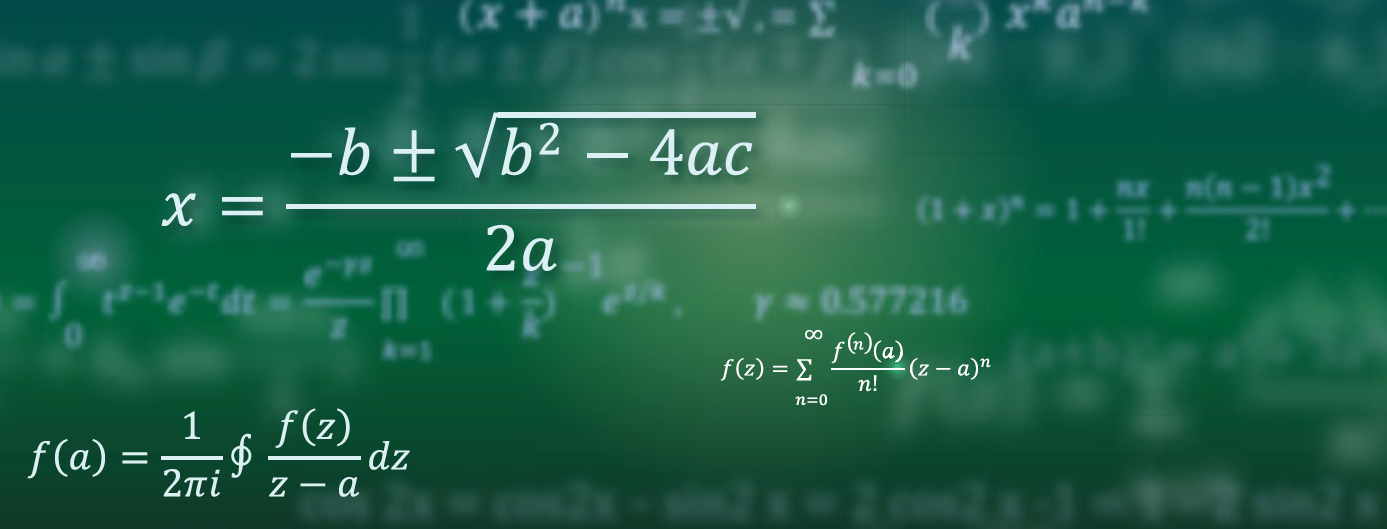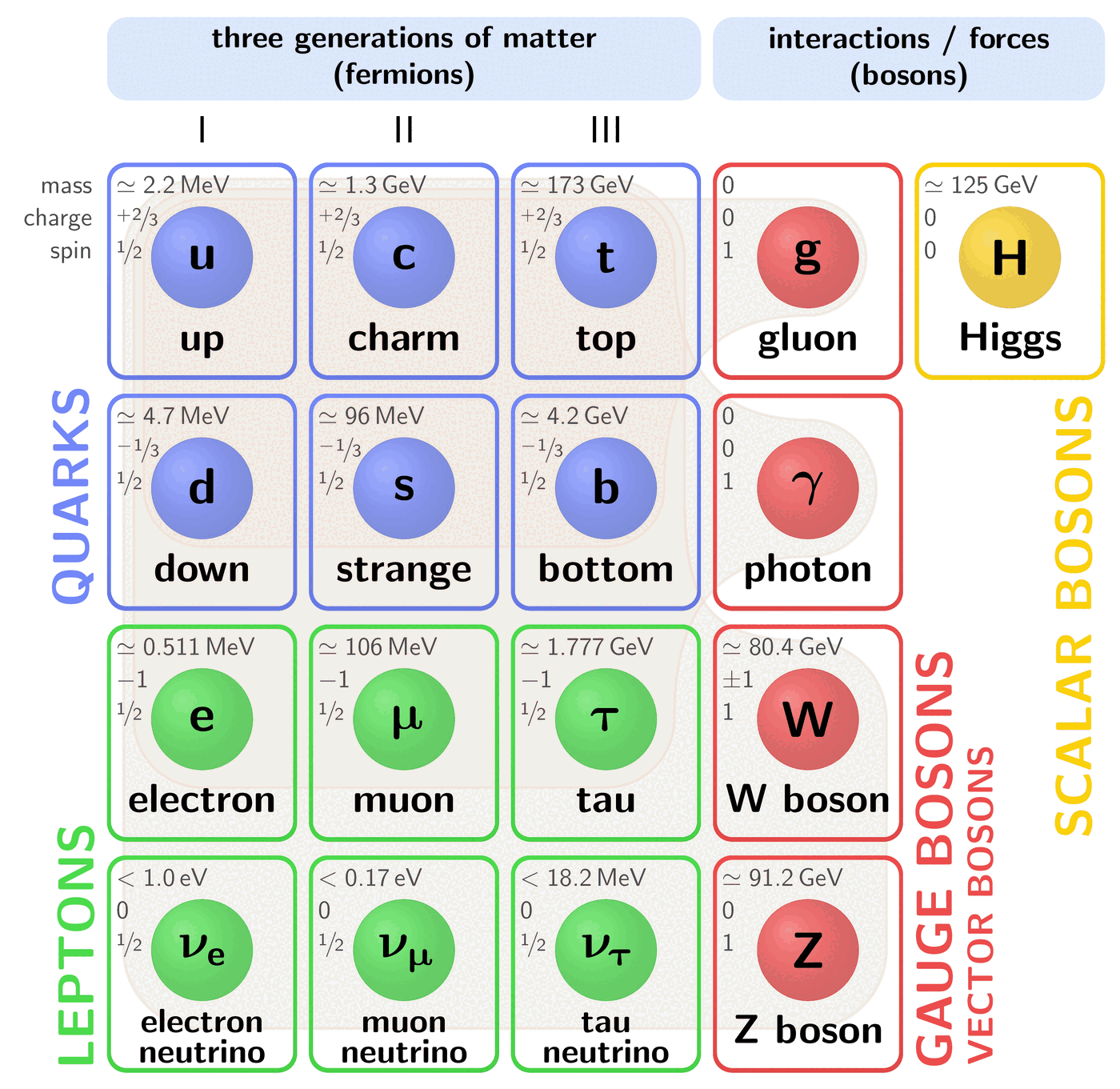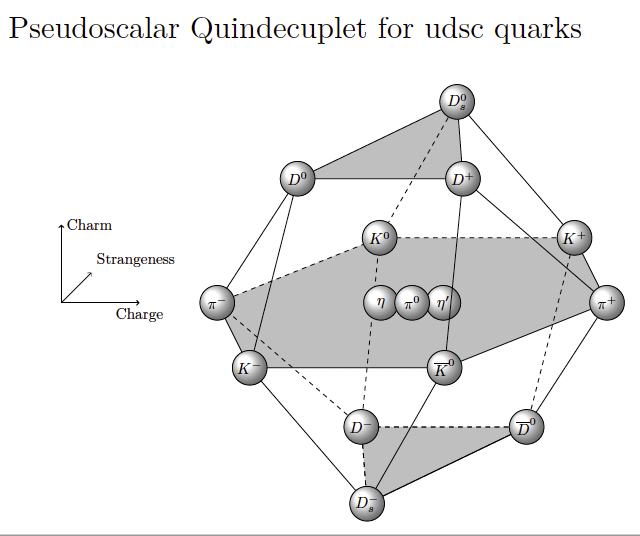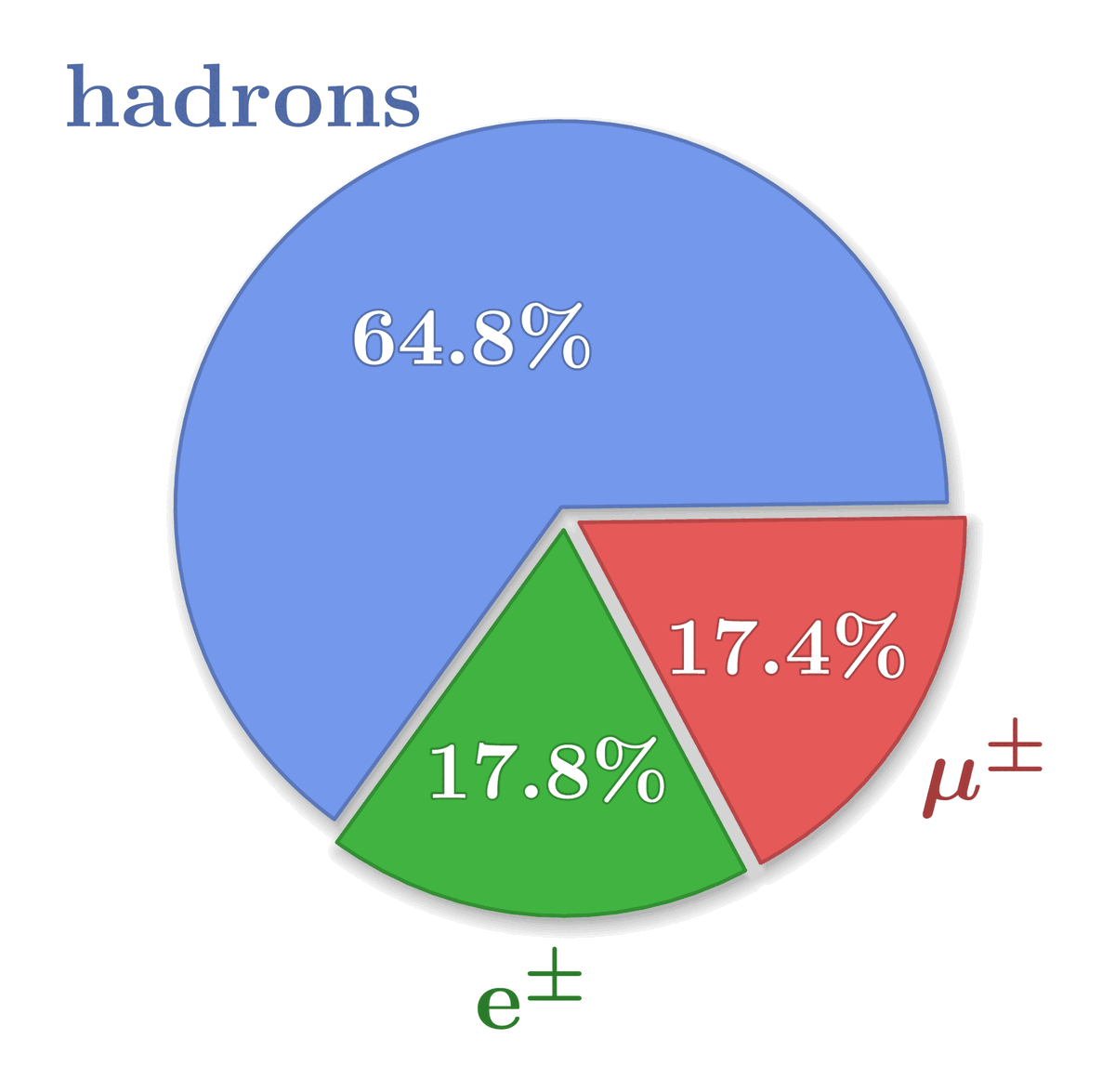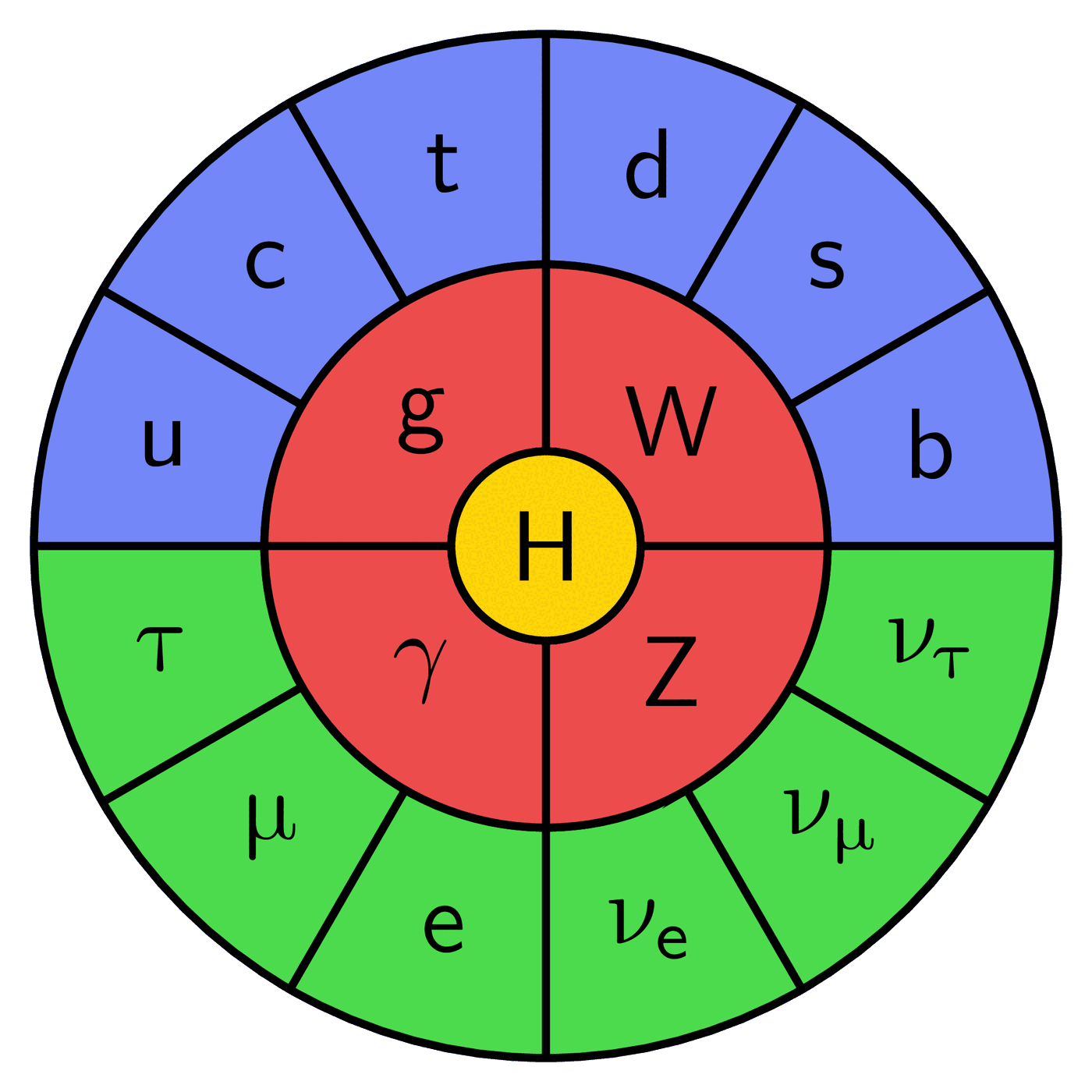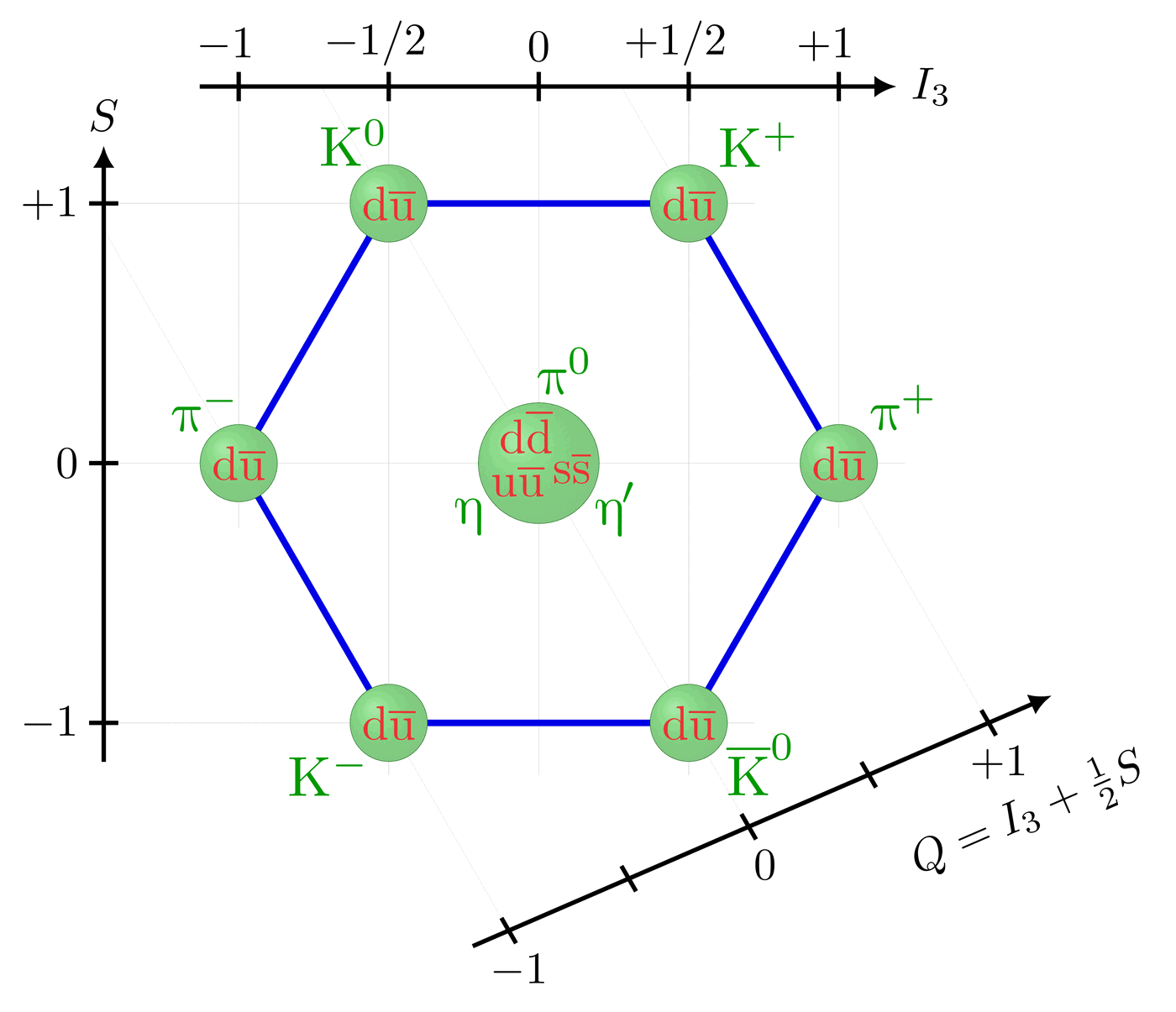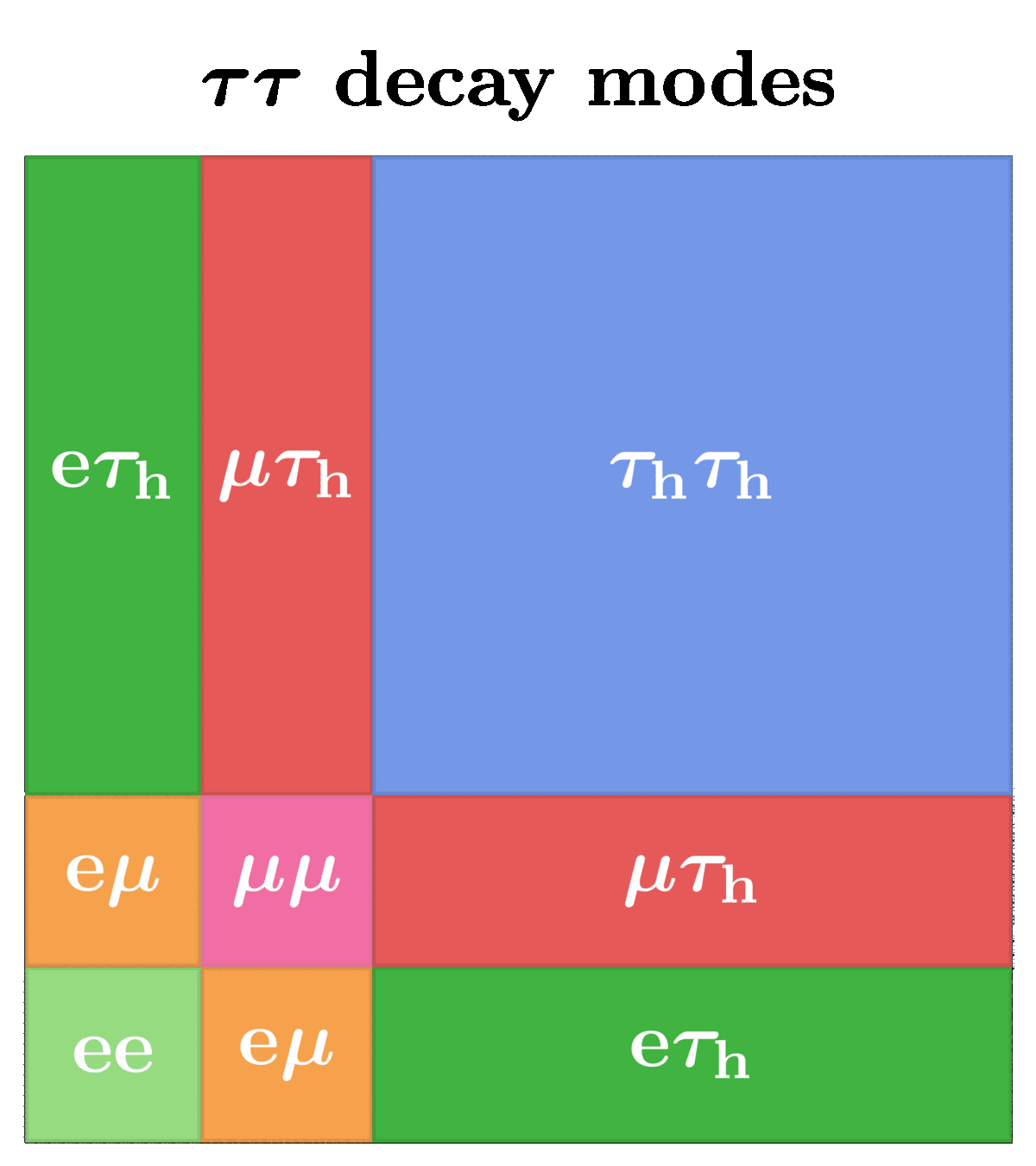Graphical representation of the weak hypercharge Y & isospin I3 quantum number (of U(1)Y and SU(2)L) of the Standard Model particles, as well as for different types of leptoquarks. Inspired by this image on Wikipedia.
All Standard Model fields: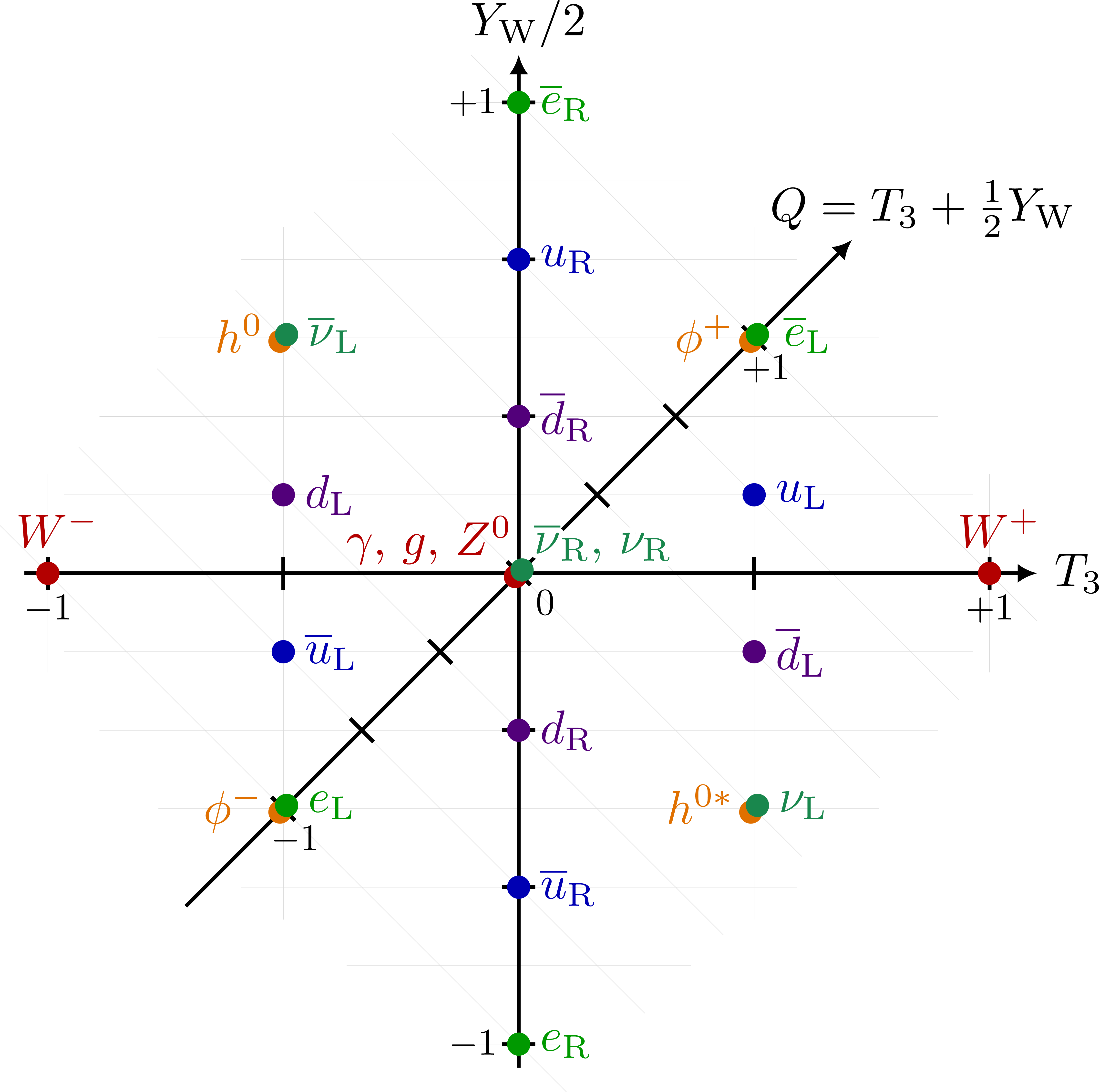 All Standard Model bosons (mass eigenstates after spontaneous symmetry breaking), grouping SU(2)L doublets and triplets:
All Standard Model bosons (mass eigenstates after spontaneous symmetry breaking), grouping SU(2)L doublets and triplets: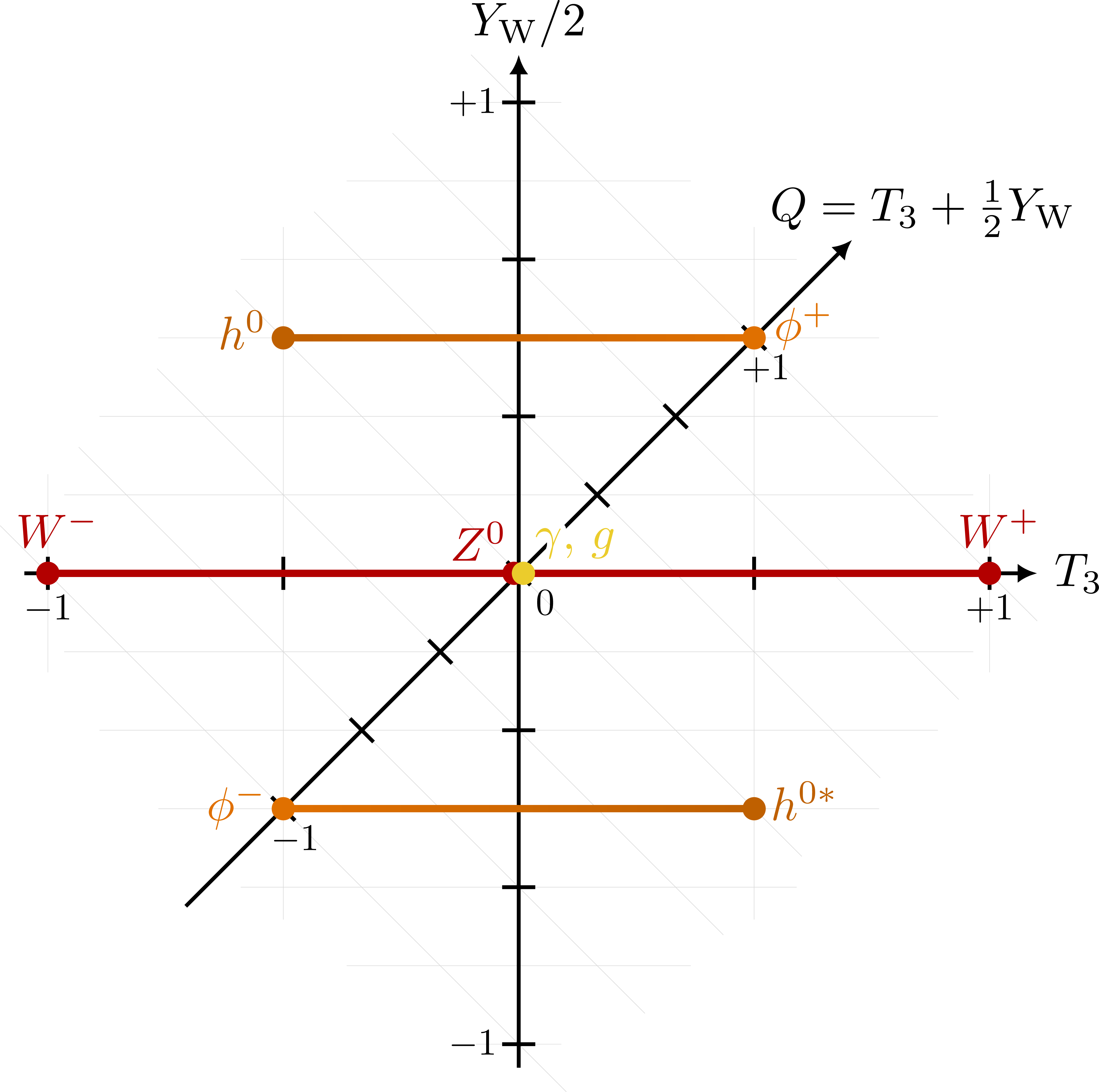 Using the common labeling of the photon and gluon fields as vector fields:
Using the common labeling of the photon and gluon fields as vector fields: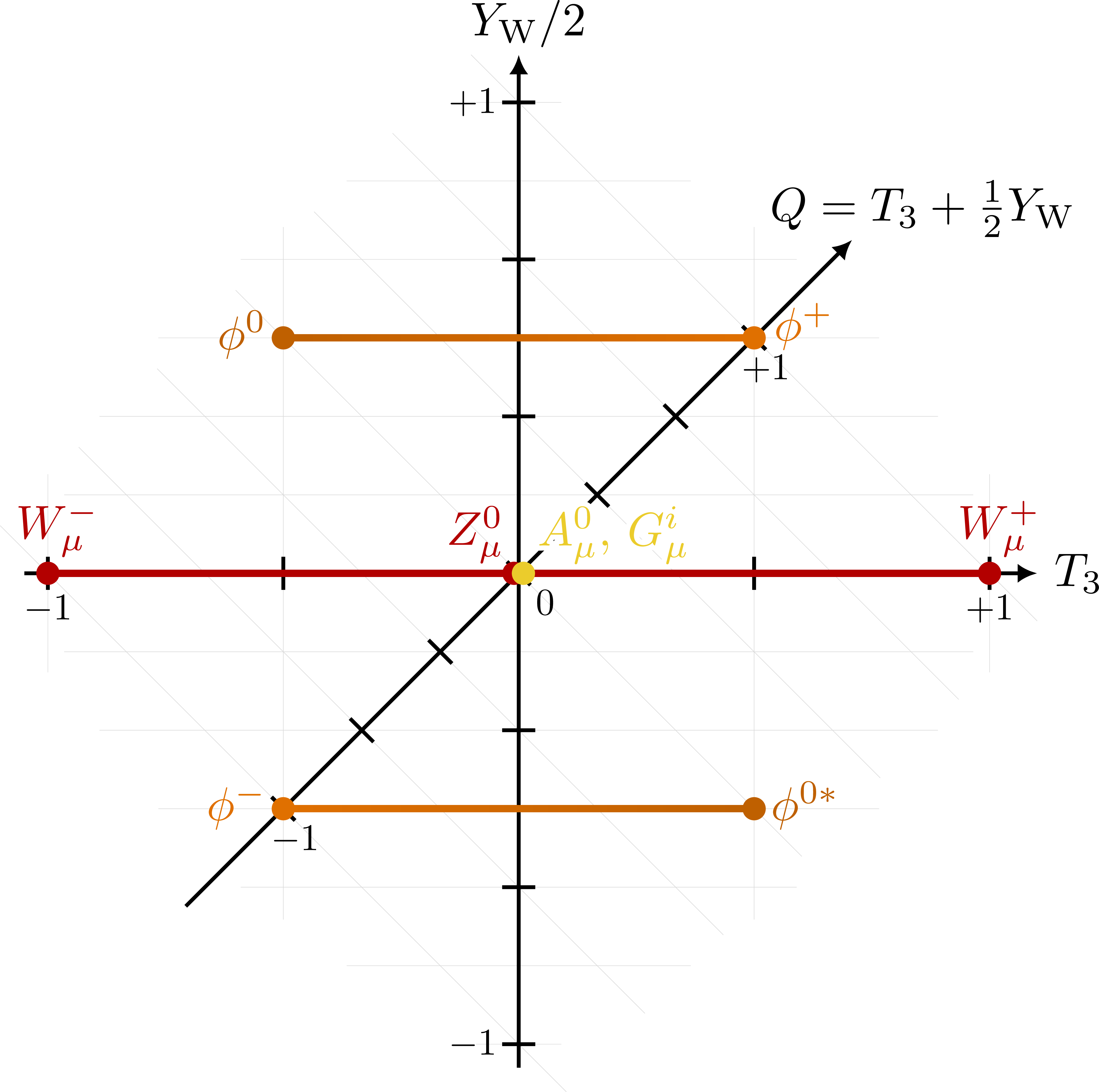 All Standard Model bosons (before spontaneous symmetry breaking):
All Standard Model bosons (before spontaneous symmetry breaking):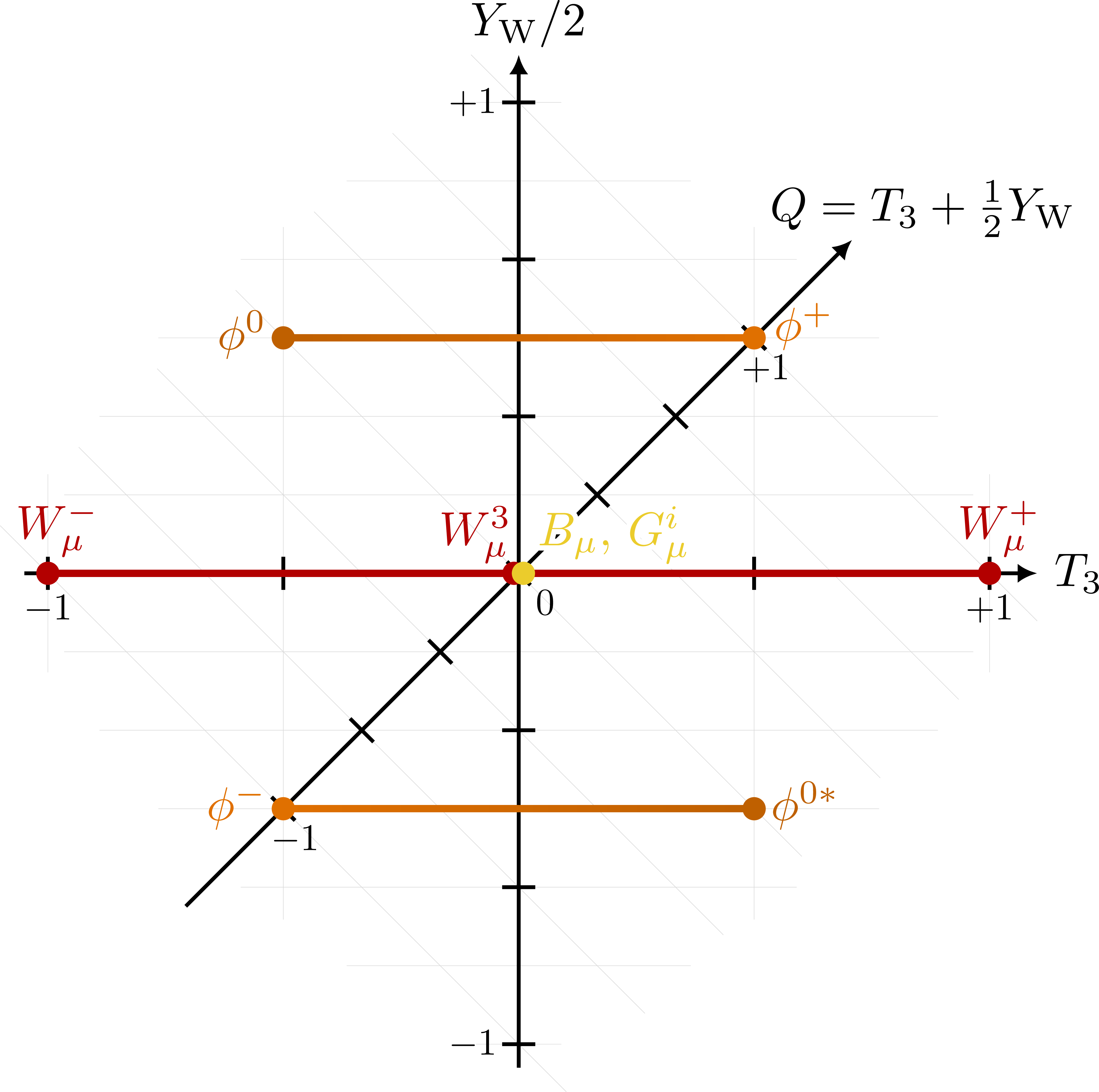 Fermions (quarks & leptons), grouping SU(2)L doublets:
Fermions (quarks & leptons), grouping SU(2)L doublets: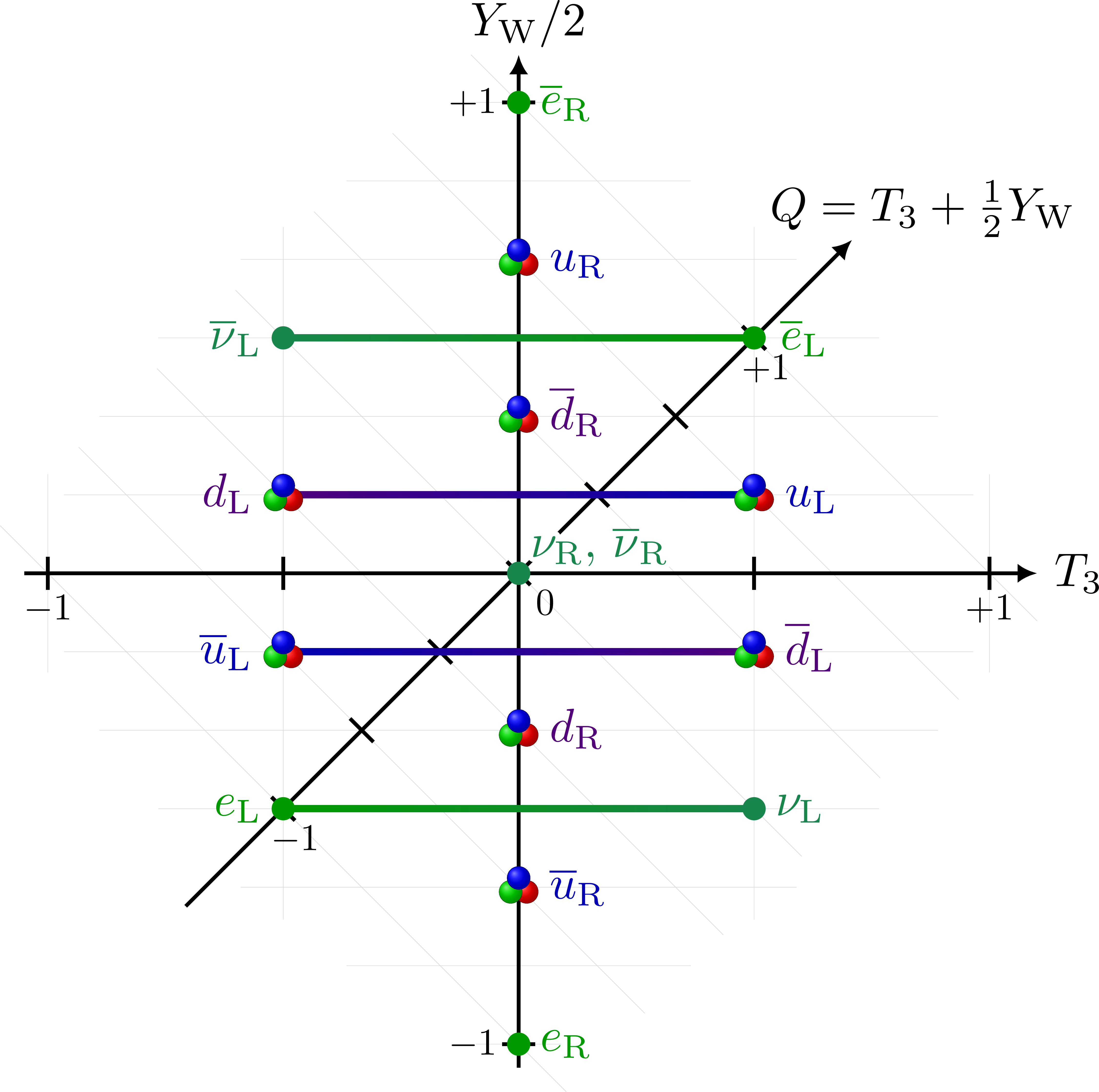 With explicit naming of the doublets:
With explicit naming of the doublets: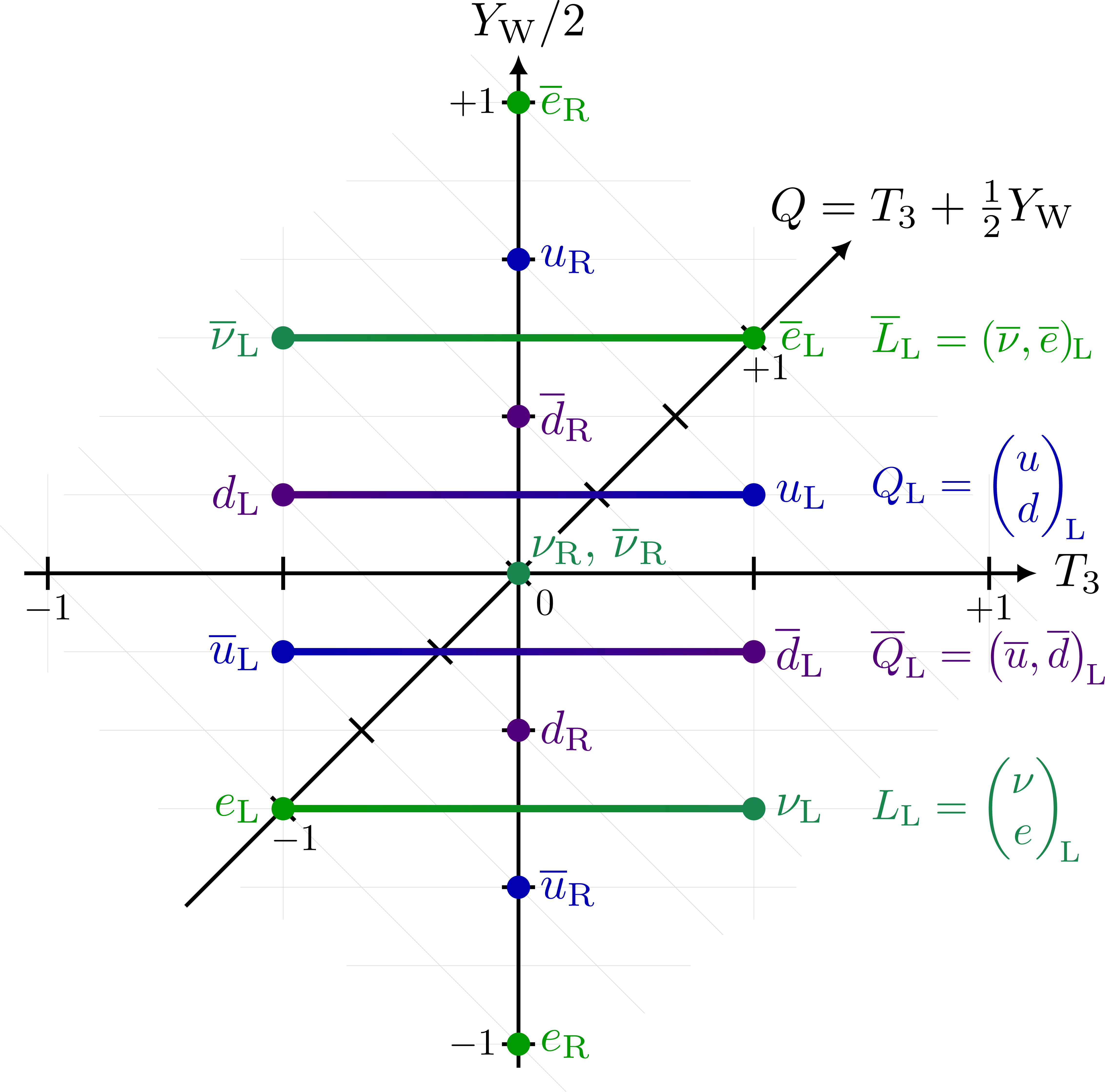 Without axes:
Without axes: Weak neutral current couplings of lepton and quark, split by axial-vector coupling (cA) and vector coupling (cV):
Weak neutral current couplings of lepton and quark, split by axial-vector coupling (cA) and vector coupling (cV):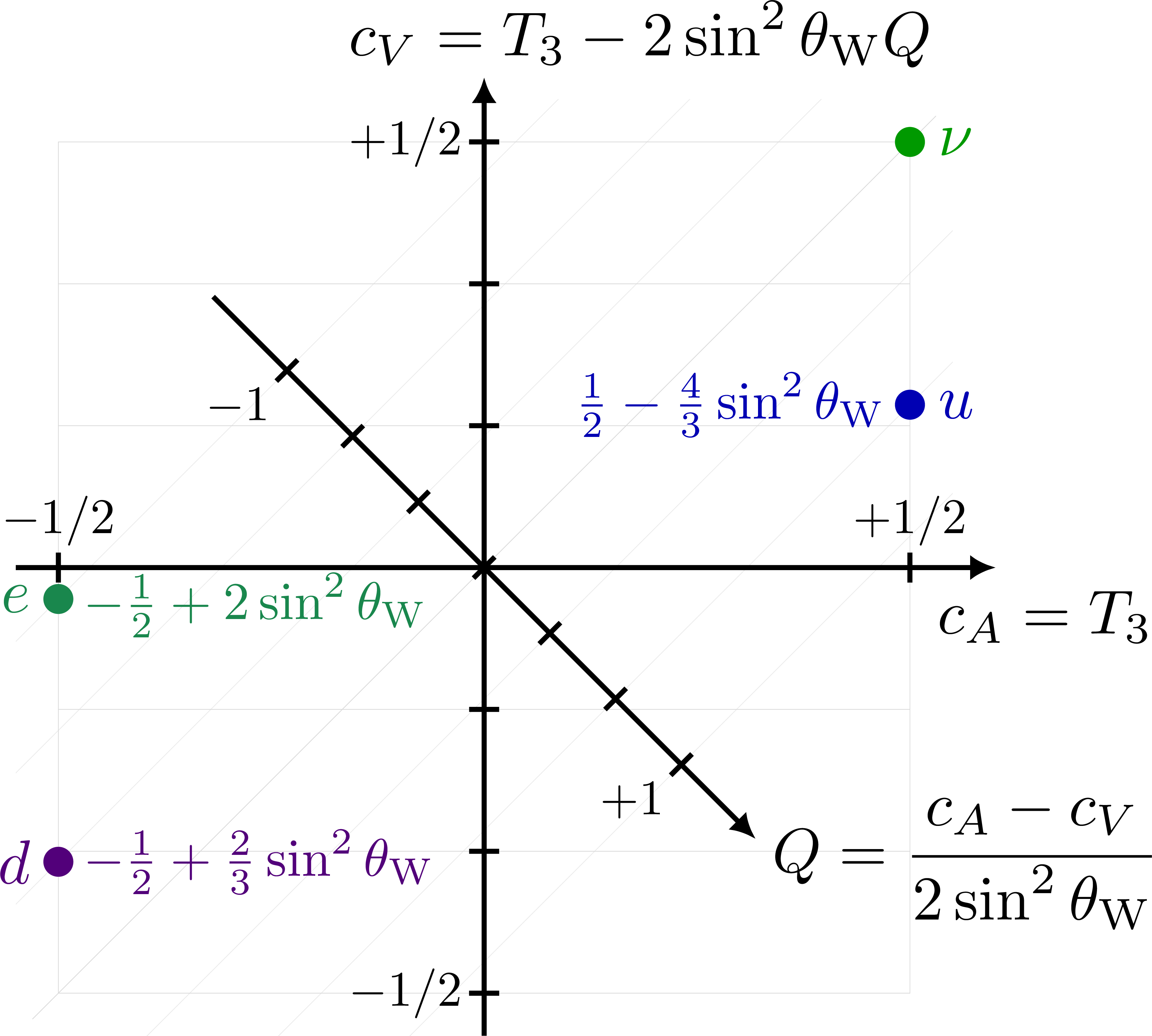 All types of leptoquarks (LQ) allowed by Standard Model symmetries (for an in-depth explanation of all LQ models and their quantum numbers, see for example I. Doršner et al.), shown as SU(2)L singlets, doublets, or triplets:
All types of leptoquarks (LQ) allowed by Standard Model symmetries (for an in-depth explanation of all LQ models and their quantum numbers, see for example I. Doršner et al.), shown as SU(2)L singlets, doublets, or triplets:
Edit and compile if you like:
% Author: Izaak Neutelings (June 2022)
% Inspiration:
% https://en.wikipedia.org/wiki/File:Electroweak.svg
% https://commons.wikimedia.org/wiki/File:Standard_Model.svg
% http://www.scientificlib.com/en/Physics/LX/WeakHypercharge.html % anti-fermions wrong ?
% https://en.wikipedia.org/wiki/Mathematical_formulation_of_the_Standard_Model#Field_content_in_detail
% https://en.wikipedia.org/wiki/C-symmetry#Charge_conjugation_in_the_chiral_basis
\documentclass[border=3pt,tikz]{standalone}
\usepackage{tikz}
\usepackage{amsmath} % for \text
\usepackage[outline]{contour} % glow around text
\usetikzlibrary{arrows.meta} % to control arrow size
\tikzset{>={Latex[length=4,width=4]}} % for LaTeX arrow head
\usetikzlibrary{calc}
\usepackage{xcolor} % for colored text
\contourlength{1.1pt}
\colorlet{myblue}{blue!70!black}
\colorlet{mydarkblue}{blue!40!black}
\colorlet{mypurple}{blue!60!red!80!black}
\colorlet{myred}{red!70!black}
\colorlet{myred2}{red!75!blue!80!black!90}
\colorlet{mydarkred}{red!50!black}
\colorlet{mygreen}{green!60!black}
\colorlet{mygreen2}{green!68!blue!70!black!90}
\colorlet{mydarkgreen}{green!30!black}
\colorlet{myorange}{orange!88!black}
\colorlet{myorange2}{orange!75!black}
\colorlet{myyellow}{yellow!80!orange!90!black}
\def\tick#1#2{\draw[thick] (#1) ++ (#2:1pt) --++ (#2-180:2pt)}
\renewcommand\bar{\overline}
\renewcommand\tilde{\widetilde}
\newcommand{\YW}{Y_\mathrm{W}}
\newcommand{\ff}[2]{#1_\text{#2}} % fermion field
\newcommand{\aff}[2]{\overline{#1}_\text{#2}} % anti-fermion field
\tikzstyle{guide}=[ultra thin,black!15,line cap=round]
\tikzstyle{myball}=[line width=0.05,ball color=#1]
% COMMON MACROS
\def\myball(#1)[#2]{
\fill[ball color=#2] (#1) circle(\r);
\fill[#2,opacity=0.4] (#1) circle(\r);
\draw[draw=#2!20!black,line width=0.04] (#1) circle(\r)
}
\def\quark(#1)[#2]#3{
\myball({#1)++(-30:0.8*\r})[red];
\myball({#1)++(-150:0.8*\r})[green!88!black];
\myball({#1)++(90:0.8*\r})[blue];
%\draw[myball=red] (#1)++(-30:0.8*\r) circle(\r);
%\draw[myball=green] (#1)++(-150:0.8*\r) circle(\r);
%\draw[myball=blue] (#1)++(90:0.8*\r) circle(\r);
\node[#2] at (#1) {\strut#3}
}
\def\barwidth{0.015} % doublet thickness
\def\doublet#1#2{\begin{pmatrix}#1\\#2\end{pmatrix}}
\def\drawdoublet[#1,#2](#3){% % rectangle with fading color
\fill[#2,left color=#1,right color=#2]%
(-1/2,#3)++(0,-\barwidth/2) rectangle++ (1,\barwidth)%
}
\def\drawtriplet[#1,#2](#3){% % rectangle with fading color
\fill[#2,left color=#1,right color=#2]%
(-1,#3)++(0,-\barwidth/2) rectangle++ (2,\barwidth)%
}
\begin{document}
% COMMON AXIS
\def\r{0.7pt} % point radius
\pgfmathsetmacro\qscale{1/sqrt(2)} % unit Q charge in (I3,YW/2)
\def\TQYaxis{
% GUIDELINES
\foreach \i [evaluate={\y=1.05*(1.2-abs(\i/2))}] in {1,2}{ % weak isospin T3
\draw[guide] (-\i/2,-\y) -- (-\i/2,\y);
\draw[guide] ( \i/2,-\y) -- ( \i/2,\y);
}
\foreach \i [evaluate={\x=0.9*(1.1-abs(\i/6)^2)}] in {1,...,6}{ % weak hypercharge Y
\draw[guide] (-\x,-\i/6) -- (\x,-\i/6);
\draw[guide] (-\x, \i/6) -- (\x,\i/6);
}
\foreach \i [evaluate={\q=\qscale*\i/3}] in {-3,...,3}{ % EM charge Q
%\draw[guide] (-1,\i/3) -- (1,\i/3);
\draw[guide,rotate=-45] (-0.85,\q) -- (0.85,\q);
\tick{45:\q}{135};
}
\begin{scope}[every node/.style={scale=0.8,inner sep=1}]
\tick{-1,0}{90} node[below] {$-1$};
\tick{-1/2,0}{90};
\tick{1/2,0}{90};
\tick{1,0}{90} node[below] {$+1$};
\tick{0,-2/3}{0};
\tick{0,-1/3}{0};
\tick{0,1/3}{0};
\tick{0,2/3}{0};
\tick{0,-1}{0} node[left] {$-1$};
\tick{0,1}{0} node[left] {$+1$};
\tick{45:-\qscale}{135} node[below] {$-1$};
\tick{0,0}{135} node[below right=0] {$0$};
\tick{45:\qscale}{135} node[below] {$+1$};
\end{scope}
% AXES
\draw[->,thick] (-1.05,0) -- (1.1,0) node[right] {$T_3$};
\draw[->,thick] (0,-1.05) -- (0,1.1) node[right=2,above=-2] {$\YW/2$};
\draw[->,thick] (45:-1) -- (45:1) node[left=18,above right=-3] {$Q=T_3+\frac{1}{2}\YW$};
}
% ELECTROWEAK HYPERCHARGE
\begin{tikzpicture}[scale=3.5]
% AXES & GUIDELINES
\TQYaxis
% GAUGE BOSONS
%\fill[myred] ( 0, 0) circle(\r) node[below right] {$\mathrm{Z}^+$};
\fill[myred,shift={(225:0.01)}] ( 0, 0) circle(\r) node[anchor=-23,inner sep=2.5] {$\gamma$, $g$, $Z^0$};
\fill[myred] ( 1, 0) circle(\r) node[right=2,above=2] {$W^+$};
\fill[myred] (-1, 0) circle(\r) node[right=2,above=2] {$W^-$};
% SCALAR BOSONS
\fill[myorange,shift={(225:0.01)}] (-1/2, 1/2) circle(\r) node[left] {\strut$h^0$};
\fill[myorange,shift={(225:0.01)}] ( 1/2,-1/2) circle(\r) node[left] {\strut$h^{0*}$};
\fill[myorange,shift={(225:0.01)}] (-1/2,-1/2) circle(\r) node[left] {\strut$\phi^-$};
\fill[myorange,shift={(225:0.01)}] ( 1/2, 1/2) circle(\r) node[left] {\strut$\phi^+$};
% QUARKS
\fill[myblue] (-1/2,-1/6) circle(\r) node[right=1] {$\aff{u}{L}$};
\fill[mypurple] (-1/2, 1/6) circle(\r) node[right=1] {$\ff{d}{L}$};
\fill[myblue] ( 0 ,-2/3) circle(\r) node[right=1] {$\aff{u}{R}$};
\fill[mypurple] ( 0 ,-1/3) circle(\r) node[right=1] {$\ff{d}{R}$};
\fill[mypurple] ( 0 , 1/3) circle(\r) node[right=1] {$\aff{d}{R}$};
\fill[myblue] ( 0 , 2/3) circle(\r) node[right=1] {$\ff{u}{R}$};
\fill[mypurple] ( 1/2,-1/6) circle(\r) node[right=1] {$\aff{d}{L}$};
\fill[myblue] ( 1/2, 1/6) circle(\r) node[right=1] {$\ff{u}{L}$};
% LEPTONS
\fill[mygreen] ( 0 ,-1 ) circle(\r) node[right=1] {$\ff{e}{R}$};
\fill[mygreen] ( 0 , 1 ) circle(\r) node[right=1] {$\aff{e}{R}$};
\fill[mygreen,shift={(45:0.01)}] ( 1/2, 1/2) circle(\r) node[right=2] {$\aff{e}{L}$};
\fill[mygreen,shift={(45:0.01)}] (-1/2,-1/2) circle(\r) node[right=1] {$\ff{e}{L}$};
\fill[mygreen2,shift={(45:0.01)}] (-1/2, 1/2) circle(\r) node[right=1] {$\aff{\nu}{L}$};
\fill[mygreen2,shift={(45:0.01)}] ( 1/2,-1/2) circle(\r) node[right=1] {$\ff{\nu}{L}$};
\fill[mygreen2,shift={(45:0.01)}] ( 0, 0) circle(\r)
node[right=1,above right=-2] {\contour{white}{$\aff{\nu}{R}$, $\ff{\nu}{R}$}}; % not in SM
\end{tikzpicture}
% ELECTROWEAK HYPERCHARGE - bosons
\begin{tikzpicture}[scale=3.5]
% AXES & GUIDELINES
\TQYaxis
% GAUGE BOSONS
\drawtriplet[myred,myred](0);
%\fill[myred] ( 0, 0) circle(\r) node[anchor=-23,inner sep=2.5] {$\gamma$, $g$, $Z^0$};
\fill[myred,shift=(0:-0.01)]
( 0, 0) circle(\r) node[anchor=-42,inner sep=2.5] {$Z^0$};
\fill[myyellow,shift=(0:0.01)]
( 0, 0) circle(\r) node[anchor=-150,inner sep=3] {\contour{white}{$\gamma$, $g$}};
\fill[myred]
( 1, 0) circle(\r) node[right=2,above=2] {$W^+$};
\fill[myred]
(-1, 0) circle(\r) node[right=2,above=2] {$W^-$};
% SCALAR BOSONS
\drawdoublet[myorange2,myorange]( 1/2);
\drawdoublet[myorange,myorange2](-1/2);
\fill[myorange2] (-1/2, 1/2) circle(\r) node[left] {\strut$h^0$};
\fill[myorange2] ( 1/2,-1/2) circle(\r) node[right] {\strut$h^{0*}$};
\fill[myorange] (-1/2,-1/2) circle(\r) node[left] {\strut$\phi^-$};
\fill[myorange] ( 1/2, 1/2) circle(\r) node[anchor=-170,inner sep=4] {\strut$\phi^+$};
\end{tikzpicture}
% ELECTROWEAK HYPERCHARGE - bosons with full field names
\begin{tikzpicture}[scale=3.5]
% AXES & GUIDELINES
\TQYaxis
% GAUGE BOSONS
\drawtriplet[myred,myred](0);
%\fill[myred] ( 0, 0) circle(\r) node[anchor=-23,inner sep=2.5] {$\gamma$, $g$, $Z^0$};
\fill[myred,shift=(0:-0.01)]
( 0, 0) circle(\r) node[anchor=-45,inner sep=2] {$Z^0_\mu$};
\fill[myyellow,shift=(0:0.01)]
( 0, 0) circle(\r) node[anchor=-157,inner sep=2.8] {\contour{white}{$A^0_\mu$, $G^i_\mu$}};
\fill[myred]
( 1, 0) circle(\r) node[right=2,above=0] {$W^+_\mu$};
\fill[myred]
(-1, 0) circle(\r) node[right=2,above=0] {$W^-_\mu$};
% SCALAR BOSONS
\drawdoublet[myorange2,myorange]( 1/2);
\drawdoublet[myorange,myorange2](-1/2);
\fill[myorange2] (-1/2, 1/2) circle(\r) node[left] {\strut$\phi^0$};
\fill[myorange2] ( 1/2,-1/2) circle(\r) node[right] {\strut$\phi^{0*}$};
\fill[myorange] (-1/2,-1/2) circle(\r) node[left] {\strut$\phi^-$};
\fill[myorange] ( 1/2, 1/2) circle(\r) node[anchor=-170,inner sep=4] {\strut$\phi^+$};
\end{tikzpicture}
% ELECTROWEAK HYPERCHARGE - bosons with full field names before SSB
\begin{tikzpicture}[scale=3.5]
% AXES & GUIDELINES
\TQYaxis
% GAUGE BOSONS
\drawtriplet[myred,myred](0);
%\fill[myred] ( 0, 0) circle(\r) node[anchor=-23,inner sep=2.5] {$\gamma$, $g$, $Z^0$};
\fill[myred,shift=(0:-0.01)]
( 0, 0) circle(\r) node[anchor=-45,inner sep=2] {$W^3_\mu$};
\fill[myyellow,shift=(0:0.01)]
( 0, 0) circle(\r) node[anchor=-157,inner sep=2.8] {\contour{white}{$B_\mu$, $G^i_\mu$}};
\fill[myred]
( 1, 0) circle(\r) node[right=2,above=0] {$W^+_\mu$};
\fill[myred]
(-1, 0) circle(\r) node[right=2,above=0] {$W^-_\mu$};
% SCALAR BOSONS
\drawdoublet[myorange2,myorange]( 1/2);
\drawdoublet[myorange,myorange2](-1/2);
\fill[myorange2] (-1/2, 1/2) circle(\r) node[left] {\strut$\phi^0$};
\fill[myorange2] ( 1/2,-1/2) circle(\r) node[right] {\strut$\phi^{0*}$};
\fill[myorange] (-1/2,-1/2) circle(\r) node[left] {\strut$\phi^-$};
\fill[myorange] ( 1/2, 1/2) circle(\r) node[anchor=-170,inner sep=4] {\strut$\phi^+$};
\end{tikzpicture}
% ELECTROWEAK HYPERCHARGE - fermions
% https://en.wikipedia.org/wiki/C-symmetry#Charge_conjugation_in_the_chiral_basis
\begin{tikzpicture}[scale=3.5]
\def\ns{\hspace{-0.1em}} % small negative space
\def\NS{\hspace{-0.2em}} % large negative space
\def\r{0.7pt} % point radius
% AXES & GUIDELINES
\TQYaxis
% ISOSPIN DOUBLETS
\drawdoublet[mygreen,mygreen2](-1/2);
\drawdoublet[mygreen2,mygreen](1/2);
\drawdoublet[myblue,mypurple](-1/6);
\drawdoublet[mypurple,myblue](1/6);
%% QUARKS
%\fill[myblue] (-1/2,-1/6) circle(\r) node[left=1] {$\aff{u}{R}$};
%\fill[mypurple] (-1/2, 1/6) circle(\r) node[left=1] {$\ff{d}{L}$};
%\fill[myblue] ( 0 ,-2/3) circle(\r) node[right=1] {$\aff{u}{L}$};
%\fill[mypurple] ( 0 ,-1/3) circle(\r) node[right=1] {$\ff{d}{R}$};
%\fill[mypurple] ( 0 , 1/3) circle(\r) node[right=1] {$\aff{d}{L}$};
%\fill[myblue] ( 0 , 2/3) circle(\r) node[right=1] {$\ff{u}{R}$};
%\fill[mypurple] ( 1/2,-1/6) circle(\r) node[right=1] {$\aff{d}{R}$};
%\fill[myblue] ( 1/2, 1/6) circle(\r) node[right=1] {$\ff{u}{L}$};
% RGB QUARK BALLS
\quark(-1/2,-1/6)[left=3,myblue] {$\aff{u}{L}$};
\quark(-1/2, 1/6)[left=3,mypurple] {$\ff{d}{L}$};
\quark( 0 ,-2/3)[right=3,myblue] {$\aff{u}{R}$};
\quark( 0 ,-1/3)[right=3,mypurple] {$\ff{d}{R}$};
\quark( 0 , 1/3)[right=3,mypurple] {$\aff{d}{R}$};
\quark( 0 , 2/3)[right=3,myblue] {$\ff{u}{R}$};
\quark( 1/2,-1/6)[right=3,mypurple] {$\aff{d}{L}$};
\quark( 1/2, 1/6)[right=3,myblue] {$\ff{u}{L}$};
% LEPTONS
\fill[mygreen] ( 0 ,-1 ) circle(\r) node[right=1] {$\ff{e}{R}$};
\fill[mygreen] ( 0 , 1 ) circle(\r) node[right=1] {$\aff{e}{R}$};
\fill[mygreen] ( 1/2, 1/2) circle(\r) node[right=2] {$\aff{e}{L}$};
\fill[mygreen] (-1/2,-1/2) circle(\r) node[left=1] {$\ff{e}{L}$};
\fill[mygreen2] (-1/2, 1/2) circle(\r) node[left=1] {$\aff{\nu}{L}$};
\fill[mygreen2] ( 1/2,-1/2) circle(\r) node[right=1] {$\ff{\nu}{L}$};
\fill[mygreen2] ( 0, 0) circle(\r)
node[right=1,above right=-2] {\contour{white}{$\ff{\nu}{R}$, $\aff{\nu}{R}$}};
\end{tikzpicture}
% ELECTROWEAK HYPERCHARGE - fermions (with doublets)
\begin{tikzpicture}[scale=3.5]
\def\ns{\hspace{-0.1em}} % small negative space
\def\NS{\hspace{-0.2em}} % large negative space
\def\r{0.7pt} % point radius
% AXES & GUIDELINES
\TQYaxis
% ISOSPIN DOUBLETS
\drawdoublet[mygreen,mygreen2](-1/2)
node[scale=0.9,below=1,right=24] {$\ff{L}{L}=\doublet{\nu}{e}_\text{\NS L}$};
\drawdoublet[mygreen2,mygreen](1/2)
node[scale=0.9,below=1,right=24] {$\aff{L}{L}=(\bar{\nu},\bar{e})_\text{\ns L}$};
\drawdoublet[myblue,mypurple](-1/6)
node[scale=0.9,below=2,right=24] {$\aff{Q}{L}=\left(\bar{u},\bar{d}\right)_\text{\ns L}$};
\drawdoublet[mypurple,myblue](1/6)
node[scale=0.9,above=1,right=24] {$\ff{Q}{L}=\doublet{u}{d}_\text{\NS L}$};
% QUARKS
\fill[myblue] (-1/2,-1/6) circle(\r) node[left=1] {$\aff{u}{L}$};
\fill[mypurple] (-1/2, 1/6) circle(\r) node[left=1] {$\ff{d}{L}$};
\fill[myblue] ( 0 ,-2/3) circle(\r) node[right=1] {$\aff{u}{R}$};
\fill[mypurple] ( 0 ,-1/3) circle(\r) node[right=1] {$\ff{d}{R}$};
\fill[mypurple] ( 0 , 1/3) circle(\r) node[right=1] {$\aff{d}{R}$};
\fill[myblue] ( 0 , 2/3) circle(\r) node[right=1] {$\ff{u}{R}$};
\fill[mypurple] ( 1/2,-1/6) circle(\r) node[right=1] {$\aff{d}{L}$};
\fill[myblue] ( 1/2, 1/6) circle(\r) node[right=1] {$\ff{u}{L}$};
% LEPTONS
\fill[mygreen] ( 0 ,-1 ) circle(\r) node[right=1] {$\ff{e}{R}$};
\fill[mygreen] ( 0 , 1 ) circle(\r) node[right=1] {$\aff{e}{R}$};
\fill[mygreen] ( 1/2, 1/2) circle(\r) node[right=2] {$\aff{e}{L}$};
\fill[mygreen] (-1/2,-1/2) circle(\r) node[left=1] {$\ff{e}{L}$};
\fill[mygreen2] (-1/2, 1/2) circle(\r) node[left=1] {$\aff{\nu}{L}$};
\fill[mygreen2] ( 1/2,-1/2) circle(\r) node[right=1] {$\ff{\nu}{L}$};
\fill[mygreen2] ( 0, 0) circle(\r)
node[right=1,above right=-2] {\contour{white}{$\ff{\nu}{R}$, $\aff{\nu}{R}$}};
\end{tikzpicture}
% ELECTROWEAK HYPERCHARGE - fermions
\begin{tikzpicture}[
scale=3.5,
]
\def\ns{\hspace{-0.1em}} % small negative space
\def\NS{\hspace{-0.2em}} % large negative space
\def\r{0.7pt} % point radius
\def\xmin{-0.8} % guideline minimum
% GUIDELINES
\foreach \i [evaluate={ % weak isospin T3
\y=1.05*(1.1-abs(\i/2))}
] in {-1,0,+1}{
\draw[guide] (\i/2,\y) -- (\i/2,-1.2)
node[black,below=-1,scale=0.85] {\strut$\i$};
}
\foreach \i [evaluate={ % EM charge Q
\q=\qscale*\i/3;
\qmin=-min(0.85,abs(\xmin*sqrt(2)-\q);
\m=mod(\i,3)==0; % \i is divisible by 3
\num=int(\i/(\m==0?1:3); % numerator
}%
] in {-3,...,3}{
\draw[guide,rotate=-45] (\qmin,\q) -- (0.9,\q)
node[black,anchor=135,inner sep=1,scale=0.85] {
\ifnum\i=0 $\phantom{+}0$
\else $\pgfmathprintnumber[print sign=true]{\num} \ifnum\m=0 /3 \fi$
\fi
};
}
\foreach \i [evaluate={ % weak hypercharge YW
\x=0.55*(1.3-abs(\i/6)^2);
\gcd=(mod(\i,2)==0?2:1)*(mod(\i,3)==0?3:1); % greatest common divisor
\den=int(6/\gcd); % denominator
\num=int(\i/\gcd); % simplified numerator
}%
] in {-6,...,6}{
\draw[guide] (\xmin,\i/6) -- (\x,\i/6);
\node[black,right=0,scale=0.85] at (-1.06,\i/6) {
\ifnum\i=0
$\phantom{+}0$ % indent Y = 0
\else
$\pgfmathprintnumber[print sign=true]{\num}
\ifnum\den=1 \else /\den \fi$
\fi
};
}
\node[right=0] at (-1.06,1.15) {$\YW/2$};
\node[right,below=-3] at (0.9,-1.2) {\strut$T_3$};
\path[rotate=-45] (0.9,1.3*\qscale) node[black,anchor=135,inner sep=1] {$Q$};
% ISOSPIN DOUBLETS
\drawdoublet[mygreen,mygreen2](-1/2);
%node[scale=0.9,below=1,right=24] {$L_R=\doublet{\nu}{e}_{\NS L}$};
\drawdoublet[mygreen2,mygreen](1/2);
%node[scale=0.9,below=1,right=24] {$\bar{L}_R=(\bar{\nu},\bar{e})_{\ns R}$};
\drawdoublet[myblue,mypurple](-1/6);
%node[scale=0.9,below=0,right=24] {$\bar{Q}_R=\left(\bar{u},\bar{d}\right)_{\ns R}$};
\drawdoublet[mypurple,myblue](1/6);
%node[scale=0.9,below=0,right=24] {$Q_L=\doublet{u}{d}_{\NS L}$};
% RGB QUARK BALLS
\quark(-1/2,-1/6)[left=3,myblue] {$\aff{u}{L}$};
\quark(-1/2, 1/6)[left=3,mypurple] {$\ff{d}{L}$};
\quark( 0 ,-2/3)[right=3,myblue] {$\aff{u}{R}$};
\quark( 0 ,-1/3)[right=3,mypurple] {$\ff{d}{R}$};
\quark( 0 , 1/3)[right=3,mypurple] {$\aff{d}{R}$};
\quark( 0 , 2/3)[right=3,myblue] {$\ff{u}{R}$};
\quark( 1/2,-1/6)[right=3,mypurple] {$\aff{d}{L}$};
\quark( 1/2, 1/6)[right=3,myblue] {$\ff{u}{L}$};
% LEPTONS
\myball( 0 ,-1 )[mygreen] node[mygreen,right=1] {$\ff{e}{R}$};
\myball( 0 , 1 )[mygreen] node[mygreen,right=1] {$\aff{e}{R}$};
\myball( 1/2, 1/2)[mygreen] node[mygreen,right=2] {$\aff{e}{L}$};
\myball(-1/2,-1/2)[mygreen] node[mygreen,left=1] {$\ff{e}{L}$};
\myball(-1/2, 1/2)[mygreen2] node[mygreen2,left=1] {$\aff{\nu}{L}$};
\myball( 1/2,-1/2)[mygreen2] node[mygreen2,right=1] {$\ff{\nu}{L}$};
\myball( 0, 0)[mygreen2] node[mygreen2,right=1,above right=-2] {$\ff{\nu}{R}$, $\aff{\nu}{R}$};
\end{tikzpicture}
% WEAK NEUTRAL-CURRENT COUPLINGS
\begin{tikzpicture}[scale=2.4]
\def\r{1.0pt} % point radius
\def\thetaW{28.8} % weak mixing angle / Weinberg angle
\def\sW{0.23153} % sin(theta_W)^2
\def\sinthetaW{\sin^2\theta_\mathrm{W}}
%\pgfmathsetmacro\sW{sin(\thetaW)^2} % sin(theta_W)
\pgfmathsetmacro\qscale{4*\sW/(sqrt(2))} % unit Q charge in (I3,YW/2)
% GUIDELINES
\foreach \i in {2}{ % axial-vector cV coupling
\draw[guide] (-\i/2,-1) -- (-\i/2,1);
\draw[guide] ( \i/2,-1) -- ( \i/2,1);
}
\foreach \i in {1,...,3}{ % vector cA coupling
\draw[guide] (-1,-\i/3) -- (1,-\i/3);
\draw[guide] (-1, \i/3) -- (1, \i/3);
}
\begin{scope}
\clip (-1.1,-1.1) rectangle (1.1,1.1);
\foreach \i [evaluate={\q=\qscale*\i/3;}] in {-3,...,3}{ % EM charge Q
\draw[guide,rotate=45] (-1.5,\q) -- (1.5,\q);
\tick{135:\q}{45};
}
\end{scope}
\foreach \i in {1,...,3}{ % ticks
\tick{0,-\i/3}{0};
\tick{0, \i/3}{0};
}
\begin{scope}[every node/.style={scale=0.8,inner sep=1}]
\tick{-1,0}{-90} node[above] {$-1/2$};
\tick{1,0}{-90} node[above] {$+1/2$};
\tick{0,-1}{0} node[left] {$-1/2$};
\tick{0,1}{0} node[left] {$+1/2$};
\tick{-45:-\qscale}{45} node[below left] {$-1$};
\tick{-45:\qscale}{45} node[below left] {$+1$};
\end{scope}
% AXES
\draw[->,thick] (-1.1,0) -- (1.2,0) node[right=8,below] {$c_A = T_3$};
\draw[->,thick] (0,-1.1) -- (0,1.15) node[right=25,above=-2] {$c_V = T_3 - 2\sinthetaW Q$};
\draw[->,thick] (-45:-0.9) -- (-45:0.9) node[above=-2,right=-1] {$Q = \cfrac{c_A - c_V}{2\sinthetaW}$};
% QUARKS
\fill[mygreen] ( 1, 1) circle(\r)
node[right=1] {$\nu$};
\fill[mygreen2] (-1,-1+4*\sW) circle(\r)
node[left=1] {$e$}
node[below=1,right=1,scale=0.85] {$-\frac{1}{2}+2\sinthetaW$};
\fill[myblue] ( 1, 1-8/3*\sW) circle(\r)
node[right=1] {$u$}
node[left=1,scale=0.85] {$\frac{1}{2}-\frac{4}{3}\sinthetaW$};
\fill[mypurple] (-1,-1+4/3*\sW) circle(\r)
node[left=1] {$d$}
node[right=1,scale=0.85] {$-\frac{1}{2}+\frac{2}{3}\sinthetaW$};
\end{tikzpicture}
% LEPTOQUARK SU(2)_L x U(1)_Y QUANTUM NUMBERS
% Inspired by
% "Physics of leptoquarks in precision experiments and at particle colliders"
% I. Dorsner, S. Fajfer, A. Greljo, J. F. Kamenik, N. Kosnik
% https://arxiv.org/abs/1603.04993
\begin{tikzpicture}[scale=3.5]
% GUIDELINES
\begin{scope}
\clip
(0,0.21) ellipse({1.12} and 1.3)
(0,0.34) ellipse({1.12} and 1.4);
\foreach \i in {1,2}{ % weak isospin T3
\draw[guide] (-\i/2,-1.6) -- (-\i/2,1.6);
\draw[guide] ( \i/2,-1.6) -- ( \i/2,1.6);
}
\foreach \i in {1,...,8}{ % weak hypercharge Y
\draw[guide] (-1.2,-\i/6) -- (1.2,-\i/6);
\draw[guide] (-1.2, \i/6) -- (1.2,\i/6);
}
\foreach \i in {-4,...,5}{ % charge Q
\draw[guide,rotate=-45]
(-1.3,\qscale*\i/3) -- (1.1,\qscale*\i/3);
}
\end{scope}
\begin{scope}[
every node/.style={scale=0.8,inner sep=1},
qlab/.style={anchor=130,inner sep=0},
]
\tick{-1,0}{90} node[below] {$-1$};
\tick{-1/2,0}{90} node[below=-1] {$-\frac{1}{2}$};
\tick{1/2,0}{90} node[below=-1] {$+\frac{1}{2}$};
\tick{1,0}{90} node[below] {$+1$};
\tick{0,-1}{0} node[left] {$-1$};
\tick{0,-1/2}{0} node[left] {$-\frac{1}{2}$};
\tick{0,1/2}{0} node[left] {$+\frac{1}{2}$};
\tick{0,1}{0} node[left] {$+1$};
\tick{0,3/2}{0} node[left] {$+\frac{3}{2}$};
\tick{45:-4*\qscale/3}{135} node[qlab] {$-\frac{4}{3}$};
\tick{45:-\qscale}{135} node[qlab] {$-1$};
\tick{45:-2*\qscale/3}{135} node[qlab] {$-\frac{2}{3}$};
\tick{45:-\qscale/3}{135} node[qlab] {$-\frac{1}{3}$};
\tick{0,0}{135} node[below right=0] {$0$};
\tick{45:\qscale/3}{135} node[qlab] {+$\frac{1}{3}$};
\tick{45:2*\qscale/3}{135} node[qlab] {+$\frac{2}{3}$};
\tick{45:\qscale}{135} node[qlab] {$+1$};
\tick{45:4*\qscale/3}{135} node[qlab] {+$\frac{4}{3}$};
\tick{45:5*\qscale/3}{135} node[qlab] {+$\frac{5}{3}$};
\end{scope}
% AXES
\draw[->,thick] (-1.05,0) -- (1.1,0) node[right] {$T_3$};
\draw[->,thick] (0,-1.05) -- (0,1.8) node[right=2,above=-2] {$\YW/2$};
\draw[->,thick] (45:-1.1) -- (45:1.4) node[left=18,above right=-2] {$Q=T_3+\frac{1}{2}\YW$};
% Scalar S3 (3,3,1/3)
\drawtriplet[myred2,myred](1/3) node[right=2] {$S_3^i$};
\fill[myred2] (-1 ,1/3) circle(\r);
\fill[myred!50!myred2] (-0.01,1/3) circle(\r);
\fill[myred] ( 1 ,1/3) circle(\r);
% Scalar R2 (3,2,7/6)
\drawdoublet[mypurple,myblue](7/6) node[right=2] {$R_2$};
\fill[mypurple] (-1/2,7/6) circle(\r); %node[right=2,above=2] {$R_3$};
\fill[myblue] ( 1/2,7/6) circle(\r);
% Scalar R2~ (3,2,1/6)
\drawdoublet[mypurple,myblue](1/6) node[right=2] {$\tilde{R}_2$};
\fill[mypurple] (-1/2,1/6) circle(\r); %node[right=2,above=2] {$\tilde{R}_3$};
\fill[myblue] ( 1/2,1/6) circle(\r);
% Scalar S1~ (3,1,4/3)
\fill[mygreen] (0,4/3) circle(\r) node[right=1] {$\tilde{S}_1$};
% Scalar S1 (3,1,1/3)
\fill[mygreen] (0.01,1/3) circle(\r) node[anchor=-135,inner sep=2] {$S_1$};
% Scalar S1- (3,1,-2/3)
\fill[mygreen] (0,-2/3) circle(\r) node[right=1] {$\overline{S}_1$};
% Vector U3 (3,3,2/3)
\drawtriplet[myred,myred2](2/3) node[below=0.5,right=2] {$U_{3\mu}^i$};
\fill[myred] (-1 ,2/3) circle(\r);
\fill[myred!50!myred2] (-0.01,2/3) circle(\r);
\fill[myred2] ( 1 ,2/3) circle(\r);
% Vector V2 (3,2,5/6)
\drawdoublet[myblue,mypurple](5/6) node[below=0.5,right=2] {$V_{2\mu}$};
\fill[myblue] (-1/2,5/6) circle(\r);
\fill[mypurple] ( 1/2,5/6) circle(\r);
% Vector V2~ (3,2,-1/6)
\drawdoublet[myblue,mypurple](-1/6) node[below=1,right=2] {$\tilde{V}_{2\mu}$};
\fill[myblue] (-1/2,-1/6) circle(\r);
\fill[mypurple] ( 1/2,-1/6) circle(\r);
% Vector U1~ (3,1,5/3)
\fill[mygreen] (0,5/3) circle(\r) node[below=0.5,right=1] {$\tilde{U}_{1\mu}$};
% Vector U1 (3,1,2/3)
\fill[mygreen] (0.01,2/3) circle(\r) node[below=0.5,anchor=-145,inner sep=1.7] {$U_{1\mu}$};
% Vector U1- (3,1,-1/3)
\fill[mygreen] (0,-1/3) circle(\r) node[below=0.5,right=1] {$\overline{U}_{1\mu}$};
\end{tikzpicture}
\end{document}
Click to download: SM_isospin_weak.tex • SM_isospin_weak.pdf
Open in Overleaf: SM_isospin_weak.tex

